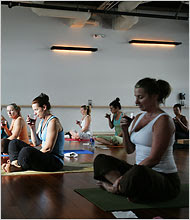Waiting outside the studio, in a noisy, busy, Saturday-morning suburban gym, Porchon-Lynch was hard to miss--tall and slender, in a crushed black velvet top, and tight leggings, elegant salt and pepper hair, and a gaggle of students around her. I put my mat at the top of the class, near hers, and was grateful to be so close-- I could barely hear her over the bump, grind, and demolishing music coming from the gym outside.We began seated with some side stretches. I'd never done many of them. She kept her eyes closed in quiet concentration.
Before the class was half over, we were doing challenging poses like krounchasana (crane pose), and sage-broken-in-eight-places. She didn't warm us up much for these so I wasn't surprised that most people in the mixed-level class of suburban professionals and parents could not do them. I could only do them because I practiced last night, and they were still challenging for me.While I worry about overstretching muscles that aren't warm enough, to my amazement, she nimbly demonstrated peacock pose, flying her legs up off the ground as though she were lifting strands of hair. She did it on her thumb-tips with her fingers in extreme flexion. I can barely do that pose with my palms flat. (I did wonder if she used that hand variation to combat arthritis.)
It made me think that --like Iyengar--Porchon-Lynch's body learned these poses young and THAT is why she can still do them. How much does the body change after 35? Her sequencing, however, was mind-boggling. What was her logic? We did a series of standing poses only on one side, and another series only on the other. She apologetically announced, in her hushed voice, that we had run out of time because there was so much she wanted to show us and it wouldn't all fit into the hour. She talked through our 5 minute savasana, final relaxation, about the energy centers in the body. I couldn't hear her very well, but when I peeked up at her, she had her eyes closed, deeply entranced in guiding our journey through the body. Her gorgeous necklace of Ganesh flanked by two suns, and her large lapis lazuli ring, plus the hot pinkish-red nail polish on toe and finger nails announced someone passionate, eccentric, devoted, spirited, and very alive.One-by-one, her students hugged her as they filed out of the room. Afterwards, she told me that she used to be a film maker, and 7 of her films were made in India. She used to pal around with Aldous Huxley in California, and she left India in 1939, one year before my own mother was born there, in New Dehli. She still has many friends in India, and leads retreats there every year. The next one—a combination of yoga retreat and tour of who she knows in Inida—will be in October, 2 months after her 89th birthday, and one month after the monsoons.Sounds like a trip not to miss.




